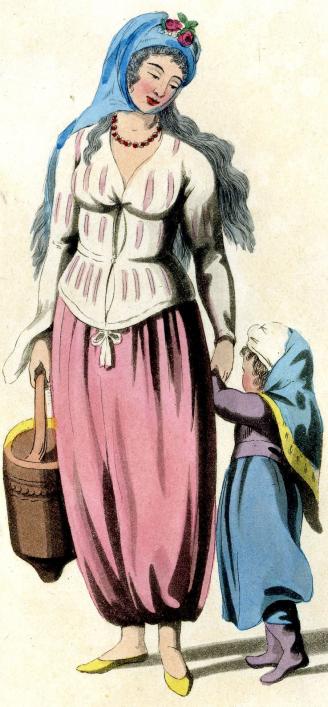Turkish trowsers

From the anonymous Annotations on 'The History of Guernsey' compiled by Mr William Berry, which takes schoolmaster and entrepreneur Berry severely to task for his numerous errors. The author takes greatest umbrage, however, on the subject of, yes, underwear. The illustrations are from the Library collection; the one above shows a Greek woman from Marmora in Turkish-style clothing.
The illustrations shown here are from a book in the Library collection, Picturesque representations of the dress and manners of the Turks: illustrated in sixty coloured engravings, with descriptions, Bulmer & Co. for John Murray, London, 1814. The engravings were 'made on the spot, about four years ago, by Monsieur Dalvimart, and may be depended upon for their correctness. Each impression has been carefully coloured according to the original drawing, that the fidelity of them might not be impaired.'¹ The lady in the red dress is an odalisque, of the 'less favoured' sort, and the drawing of the elegant woman and child above depicts a Greek from the island of Marmora. You may wonder how these ladies are linked with the Annotations: read on.
From the Annotations, p. 32.²
My labours are now nearly at an end, for I have come to Mr. BERRY’s CONCLUSION.—GENERAL OBSERVATIONS. In this he says:-
Dancing on the principal holidays or festivals is a favourite amusement; and riding parties in the month of August, probably originating in the religious processions of the Abbot of St Michael, is another diversion almost religiously attended to by the country people; most of the females still adhering to the old custom of riding, a-straddle, upon large straw mats, with stirrups slung across, not for the purpose of shewing the thinness of their ankles or the beauty of a well-turned leg, which, from the shortness of the petticoats, is generally exhibited as high as the knee; for the Turkish trowser has not yet been introduced, though it is to be hoped, for the sake of decency, that they all wear drawers.
I never was so much inclined to quarrel with Mr BERRY, as I am for this paragraph. Whenever I can, I love to shield a woman, and indeed it is the duty of every man to do so. My blood still runs warmly through my veins, and rebels almost as much against him, who deteriorates from female loveliness and delicacy. As it does, when roused, by the witchery of that excellence I would defend. Either Mr BERRY, or I, must have seen with inverted optics, for I have scarcely ever beheld a woman riding a-straddle. The amusement of tollutation, is certainly innocent, and I take it that it is as natural for the people of this island to enjoy themselves during the period of their festival, as those of any other country. The Carnival at Rome, Vienna, and all places subject to Popery, exhibits far greater mountebank scenes than those displayed by the people of Guernsey, in taking a country ride; yet no-one condemns them, and persons flock from all quarters of the globe to be present at them.

The Compiler of the History of Guernsey is evidently too nice, when he says the Turkish trowser, has not yet been introduced, though it is to be hoped for the sake of decency, that they all wear drawers. Why does Mr BERRY hope that they all wear drawers for the sake of decency? His own words prove there is no necessity for them, because had there been any indelicate exposure, so that drawers were actually required, he would have known whether they were worn or not. The country girls are generally extremely well-looking, and I have no doubt, that among them there are to be found ‘thick-legged damsels, thin legged damsels, dainty damsels, dowdy damsels &c.,' though I should never judge of the beauty of a country by the appearance of one, no more than I would say a man’s grounds had wood on them because there was a gibbet erected there.
¹ This volume was originally published in 1802, and the illustrations therefore date from around 1798. The text is thought to be by diplomat William Alexander (1767-1816), Keeper of Prints and Drawings at both the British Museum and British Library from 1808, after other authors. Octavian Dalvimart, the artist, was in Athens in 1797, but nothing else significant is known about him. The 1802 edition, which had text in both English and French, has a frontispiece vignette which our edition is lacking. From a comparison with the watercolours of 1802 it is obvious that our illustrations have not only been re-coloured, but also re-drawn and therefore re-engraved, and are as a result less fine than the originals, although all sixty in our later edition are coloured; some in the original edition are not.
² 'This critique of Berry's History of Guernsey, which appeared originally without any name of the writer, in the form of a supplement in consecutive numbers, from the 14th October to the 2nd of December 1815, of Le Miroir Politique, a weekly newspaper published in French and English, printed, published and probably edited by Mr Thomas de la Rue.' So said Edgar MacCulloch, in a note on his own copy of the Annotations, which Edith Carey tells us he gave to the Library of Elizabeth College.
The author of the Annotations mainly takes issue with Berry on historical facts concerning island history, but also accuses him of contradicting himself on a touchy subject very close to Guernsey hearts: for encouraging the monarch to ‘ere long bestow upon them all the inestimable benefits of the English constitution,’ but in the Preface to hope that their ‘unshaken loyalty may recommend them to Your Royal Highnesses gracious protection, in the enjoyment of these laws and privileges so often approved and confirmed by former sovereigns’. For a biography of Berry, see Clark, R., 'William Berry and his History of Guernsey', Report and Transactions of the Société Guernesiaise, XII (2) 1987, pp. 258 ff.
